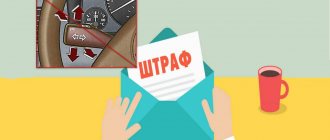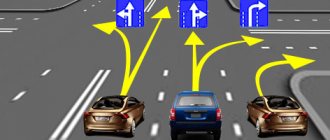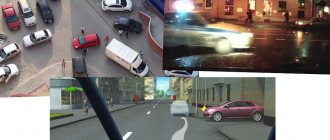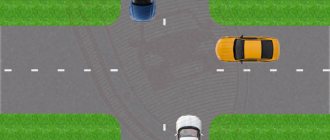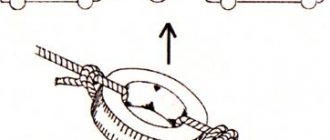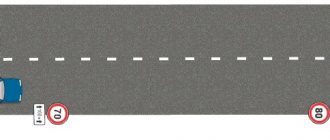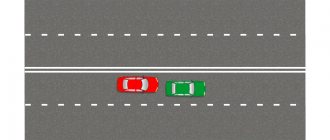Before starting a maneuver, paragraph 8.1 of the traffic rules obliges you to give the appropriate turn signal.
Giving a turn signal is not just a traffic requirement. This is informing other traffic participants of your intention to begin the maneuver. The advantage of a car with a turn signal on is at the end of the article.
A maneuver should be understood as any change in the direction of movement from a straight line (changing lanes, turning, turning, stopping), as well as the “exit” of the car from a state of rest (starting to move). More information about maneuvers can be found in the article What is a “maneuver” in traffic rules.
Signals of the corresponding direction are given by light direction indicators (“turn signals”), and in case of their malfunction or complete absence (for example, as on a bicycle), by hand.
As a process, a turn signal is the inclusion of light direction indicators on the side of the vehicle in which the maneuver is supposed to be performed, or it is a hand gesture from among those specified in paragraph 8.1 of the traffic rules, which is clearly interpreted as a turn in the appropriate direction.
Thus, giving a turn signal makes the car predictable for drivers of other vehicles - its intentions become clear.
Turn signal
Turn signal lights in a car are located in the front, rear and sides of the body (repeaters). If the maneuver is made to the right, then you should turn on the right turn indicators, if to the left, then, accordingly, turn on the left turn indicators.
Externally, i.e. Looking from the side, the turn signal is a uniformly flashing yellow or orange light on one side of the car.
Technically, turning on the turn signals occurs by switching the lever under the steering wheel to the desired position from the neutral (middle) position. The lever is located in such a way that, during steering, the left hand can easily reach it without lifting it from the steering wheel (on right-hand drive cars, switching is done with the right hand).
Moving the lever to the right of the middle position (up, relative to the steering column), together with turning the steering wheel to the right, turns on the right turn indicators; moving the lever to the left of the middle position (down, relative to the steering column) turns on the left turn indicators.
It’s easy to remember: in which direction you turn the steering wheel, move the turn signal switch lever in the same direction along the line of rotation.
Before turning while reversing, the turn signal signals must be turned on exactly according to the same principle: turn right and back - turn on the right turn signal, turn left and back - turn on the left turn signal.
About other, informal, “turn signal” signals, which can be classified as communication signals on the road, see the article Turn Signals.
Why do drivers turn on their left turn signal when turning right?
Traffic rules were created to be followed by motorists, not just printed in a book. A turn signal is an element with which we warn other drivers while driving about our intentions to perform a particular maneuver. Despite such a basic device and principle of operation, many still do not know how to operate it and in what cases to use it.
On the road, you can often encounter drivers who turn right and at the same time turn on the left turn signal. And this happens not in front of a roundabout, but on a regular road with an intersection. Let's consider why motorists perform such actions and why it is highly recommended not to repeat this. The Rules of the Road clearly state that you need to turn on the turn signal in accordance with the maneuver. For example, if the car goes to the right, you need to turn on the right indicator, if it goes to the left, then the left one. It would seem that everything is so logical that it can be confused at all.
Now let's delve into the details and imagine the situation - in a dense stream, a car turns to the right, and at the same time, it must wedge itself into its stream. Since all drivers from this lane are driving on the left, they simply cannot see his signal. Therefore, the reason for turning on the left turn signal is that the indicator is simply not visible. Of course, such actions are prohibited, but what can you do, sometimes your own life is worth more than fines. Indeed, there are several shortcomings in the Traffic Rules that interfere with convenient road traffic.
It is no longer possible to find a logical explanation for such a maneuver. When experts conducted a survey and found out how many drivers do this on the road, they were able to find out some of the reasons. This is explained by the fact that when entering their lane, they want to immediately change into the left lane. However, such maneuvers are prohibited by the rules. If you plan to go right, then you need to turn on the corresponding sign, and not think about where you will turn in 100 meters. The main danger of such actions is not the possibility of receiving a fine. In fact, this poses a great threat to other road users, who will not always be able to figure out in time what the driver in front is doing. As a result, the matter may lead to a traffic accident.
Bottom line . Some motorists turn on the left indicator before making a right turn. This sounds very illogical and looks even stranger. Drivers justify such actions with certain reasons, but none of them are comparable with the Rules of the Road, which state that when performing a maneuver, the process must be supplemented with an appropriate turn signal.
Hand turn signals
Turn signals with your hand(s) are described in detail in paragraph 8.1 of the traffic rules. Hand gestures with corresponding meanings are shown in the picture below.
Nowadays it is rare to see a hand signal giving a turn signal. In approved cases, traffic regulations require this, but implementation remains at the driver’s discretion. Much more often you can find a maneuver being carried out without giving a turn signal at all, even if it is technically sound! signs.
When you are following a car and you realize that it is maneuvering without giving any signals, it makes sense to increase your vigilance. It is quite possible that the malfunction occurred recently, and he is on his way to the repair site.
In this case, it is advisable to increase the distance to him and monitor the trajectory of his movement. I suggest reading the article Why it is important to keep your distance.
Road situations when you need to turn on your turn signals
Traffic rules clearly structure situations when the driver must use directional signals when starting a trip in front of the roundabout, or when entering a turn:
- Before the immediate start of the vehicle’s movement, as well as its stop (parking), when entering for a maneuver;
- Before any turn, U-turn and entry, as well as when driving in a circle - when entering a ring, every driver must know which turn signal to turn on in this or that case.
- When overtaking or changing lanes (during overtaking, the turn signal is used before the start and end of the maneuver being performed).
Traffic rules regulate what actions need to be taken if for some reason the lights are faulty and the turn signals need to be turned on, but cannot be turned on at the roundabout (in a circular motion).
The driver and passenger are not exempt from liability; they are required to give turn signals with their hand extended out the side window:
- If the trajectory goes to the left - straight, extended left arm / bent right arm;
- If the trajectory goes to the right - straight outstretched right arm / bent left arm;
- If the driver intends to stop - any hand extended upward.
Some drivers are mistaken when they believe that turning on the turn signals at a roundabout, intersection, or when making a U-turn according to traffic rules gives them some kind of advantage on the road. This is not true; the use of signals has a purely warning purpose. Any maneuvering must be carried out if it does not interfere with other road users.
Of course, any movement must be accompanied by a thorough knowledge of traffic rules and road signs.
For example, the fact that he is on a main road does not relieve the driver from liability. This gives priority to the order of movement, but does not in any way “reward” the driver with the right of permissiveness. Entry to the main road, exit from it, as well as movement along the main road changing its trajectory must be carried out exclusively with indication signals.
The use of turn signals is not required only when the direction of the road itself changes without crossing it with main or secondary routes.
What does it mean in advance?
What does it mean to give a turn signal in advance? In advance - this means such time before the start of the maneuver that other drivers will be able to understand and correctly interpret your intention.
The amount of this “advance” depends on the speed of your vehicle and the speed of traffic in general, as well as the nature of the road terrain, so that the inclusion of the turn signal does not confuse other motorists.
It must be taken into account that in a unit of time at high speed a car will cover a greater distance than in the same unit of time at a lower speed. For example, at a speed of 40 km/h in one second a car will travel a little more than 10 meters, at a speed of 70 km/h - almost 20 meters.
It takes time for others to notice your turn signal on and take note of it. Therefore, the higher the speed of your car, the earlier you should turn on the turn signal.
Another thing about signaling early is that turning on your turn signal is more important to the driver behind you than to the driver ahead of you.
When the driver behind you sees your signal to turn or change lanes, he, since he is moving in the same direction, can plan his actions in advance in the safest way. For example, drive around your car in a timely manner from a convenient side.
If one of the motorists ahead in traffic, waiting for you to pass in order to give way to you, misinterprets your turn signal and starts moving, then in order to avoid a collision, it makes sense for you to take control of the situation: either honk your horn and drive through, or slow down and let it pass.
Remember that by having the right of way and giving way, you are not violating traffic rules.
When should the turn signal be stopped?
In accordance with paragraph 8.2 of the traffic rules, the signal from the direction indicators must be stopped immediately after completing the maneuver. If the signal is given by hand, the hand can be lowered (grasp the steering wheel) immediately before performing the maneuver.
The turn signal may not be turned off if, after completing one maneuver (for example, changing lanes to the left), another maneuver in the same direction (for example, a left turn or a U-turn) almost immediately follows.
When should you turn on your turn signals?
| 1. | At your own discretion. |
| 2. | Just before a turn or turn. |
| 3. | Well in advance of the maneuver. |
The turn signal or hand signal must be given well in advance of the maneuver and cease immediately after completion (the hand signal may be terminated immediately before the maneuver). In this case, the signal should not mislead other road users.
Does signaling with turn signals give you an advantage in traffic?
Signaling does not give the driver an advantage or relieve him from taking precautions. This is stated in paragraph 8.2 of the traffic rules. Giving a turn signal (turning the turn signal on) only informs other road users of your intention to change direction.
But in different traffic situations, depending on expediency, another driver has the right to give up his right to priority to you. Such “concessions” can often be noticed while driving on multi-lane roads. I recommend the article Simultaneous lane changes on a multi-lane road.
In such circumstances, before changing lanes, you first need to make sure that they are giving way to you (letting you go ahead). How to avoid a collision in this case, I suggest reading the article Turn signal, changing lanes and overtaking.
